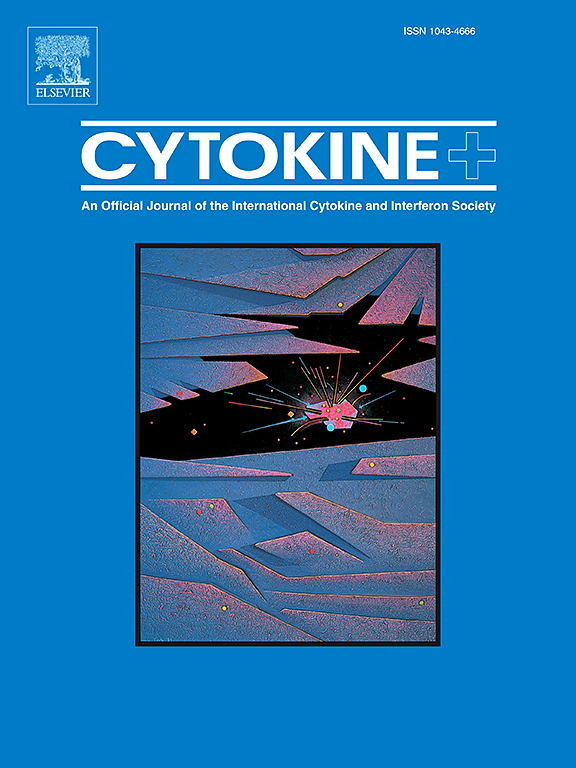房水介质水平作为年龄相关性黄斑变性抗vegf反应的生物标志物
IF 3.7
3区 医学
Q2 BIOCHEMISTRY & MOLECULAR BIOLOGY
引用次数: 0
摘要
目的监测treatment-naïve新生血管性年龄相关性黄斑变性(nAMD)患者接受抗vegf玻璃体内注射(IVIs)治疗的眼内介质动力学,以确定与治疗反应相关的个体介质模式。设计介入性、单中心、前瞻性临床研究。ParticipantsTreatment-naïve nAMD患者。方法在基线(第一次抗vegf静脉注射前)和第二次、第三次抗vegf静脉注射前,采用透明角膜穿刺术采集水样(100 ~ 200 μL)。采用多重阵列法测定13种眼内介质(VEGF-A、VEGF-C、PlGF、IL-1β、IL-6、IL-10、IL-18、CXCL1、CXCL5、CXCL7、CXCL8、MIP-1α和TNFα)的水平。主要结局测量:主要终点是眼内炎症介质水平从基线到第3个月的变化。次要终点是基线至第4个月之间最佳矫正视力(BCVA)和视网膜中央厚度(CRT)的变化。结果15只眼纳入研究。BCVA在整个研究过程中保持稳定(p = 0.07)。抗vegf静脉注射后,CRT、视网膜中央凹厚度、视网膜内液和视网膜下液的存在显著降低(p <;0.0001, p <;0.0001, p <;0.001和p <;分别为0.001)。抗vegf静脉注射后,VEGF-A水平显著降低(p <;0.0001)。所有其他介质水平均无显著差异。3例患者基线VEGF-A水平≤50 pg/mL, IL-6基线水平升高(p = 0.05), IL-6 (p = 0.03)、PlGF (p = 0.02)、VEGF-C (p = 0.005)、IL-8 (p = 0.04)、tnf - α (p = 0.013)水平首次IVI后升高。临床反应良好的患者基线VEGF-A水平明显较高(p = 0.007)。在负荷剂量后8周内进行第四次静脉注射的患者有更高的基线TNFα水平(p = 0.05);第一次体外注射后MIP-1α水平升高(p = 0.045);第二次IVI后TNFα (p = 0.026)和IL-8 (p = 0.029)水平升高。结论抗vegf静脉注射后,除VEGF-A水平显著下降外,所研究介质的房水水平保持稳定。低基线眼内VEGF-A水平(即≤50 pg/mL)的患者显示出眼内炎症特征,IL-6、PlGF、VEGF-C、IL-8和tnf - α水平升高。治疗反应与高基线VEGF-A水平相关。间隔>;第三次和第四次抗vegf静脉注射之间的8周与促血管生成/促炎症环境相关。本文章由计算机程序翻译,如有差异,请以英文原文为准。
Aqueous humor mediator levels as biomarkers of anti-VEGF response in age-related macular degeneration
Purpose
To monitor intraocular mediator dynamics in treatment-naïve neovascular age-related macular degeneration (nAMD) patients treated with anti-VEGF intravitreal injections (IVIs) to identify individual mediator patterns correlating with treatment response.
Design
Interventional, monocentric, prospective, clinical study.
Participants
Treatment-naïve nAMD patients.
Methods
Aqueous humor samples (100–200 μL) were collected by clear cornea paracentesis at baseline (before the first anti-VEGF IVI) and before the second and third anti-VEGF IVIs. The levels of 13 intraocular mediators were measured (VEGF-A, VEGF-C, PlGF, IL-1β, IL-6, IL-10, IL-18, CXCL1, CXCL5, CXCL7, CXCL8, MIP-1α and TNFα) using multiplex arrays.
Main outcomes measures
The primary endpoint was the changes in intraocular inflammatory mediator levels between baseline and month 3. Secondary endpoints were the changes in best-corrected visual acuity (BCVA) and Central Retinal Thickness (CRT) between baseline and month 4.
Results
Fifteen eyes were included in the study. BCVA remained stable throughout the study (p = 0.07). CRT, foveal thickness, and the presence of intraretinal and subretinal fluid significantly decreased after anti-VEGF IVIs (p < 0.0001, p < 0.0001, p < 0.001 and p < 0.001, respectively). After anti-VEGF IVIs, VEGF-A levels significantly decreased (p < 0.0001). No significant differences in all other mediator levels were observed. Three patients had baseline VEGF-A levels ≤50 pg/mL: they showed higher baseline IL-6 levels (p = 0.05), and elevated IL-6 (p = 0.03), PlGF (p = 0.02), VEGF-C (p = 0.005), IL-8 (p = 0.04), and TNFα (p = 0.013) levels after the first IVI. Good clinical responders had significantly higher baseline VEGF-A levels (p = 0.007). Patients who required a fourth IVI within 8 weeks of the loading dose had higher baseline TNFα levels (p = 0.05); higher MIP-1α levels after the first IVI (p = 0.045); and elevated TNFα (p = 0.026) and IL-8 (p = 0.029) levels after the second IVI.
Conclusions
The aqueous humor levels of the studied mediators remained stable after anti-VEGF IVIs, except for a significant decrease in VEGF-A levels in all patients. Patients with low baseline intraocular VEGF-A levels (i.e., ≤50 pg/mL) showed an intraocular inflammatory profile with elevated IL-6, PlGF, VEGF-C, IL-8 and TNFα levels. Treatment response correlated with high baseline VEGF-A levels. An interval > 8 weeks between the third and fourth anti-VEGF IVIs was associated with a pro-angiogenic/pro-inflammatory environment.
求助全文
通过发布文献求助,成功后即可免费获取论文全文。
去求助
来源期刊

Cytokine
医学-免疫学
CiteScore
7.60
自引率
2.60%
发文量
262
审稿时长
48 days
期刊介绍:
The journal Cytokine has an open access mirror journal Cytokine: X, sharing the same aims and scope, editorial team, submission system and rigorous peer review.
* Devoted exclusively to the study of the molecular biology, genetics, biochemistry, immunology, genome-wide association studies, pathobiology, diagnostic and clinical applications of all known interleukins, hematopoietic factors, growth factors, cytotoxins, interferons, new cytokines, and chemokines, Cytokine provides comprehensive coverage of cytokines and their mechanisms of actions, 12 times a year by publishing original high quality refereed scientific papers from prominent investigators in both the academic and industrial sectors.
We will publish 3 major types of manuscripts:
1) Original manuscripts describing research results.
2) Basic and clinical reviews describing cytokine actions and regulation.
3) Short commentaries/perspectives on recently published aspects of cytokines, pathogenesis and clinical results.
 求助内容:
求助内容: 应助结果提醒方式:
应助结果提醒方式:


